Physical Address
304 North Cardinal St.
Dorchester Center, MA 02124
Cardiac tumors are rare. In general, a cardiac mass is more likely a vegetation or a thrombus than a tumor. Secondary (metastatic) tumors are far more common than primary cardiac tumors. Among primary cardiac tumors, benign lesions are more common than malignant tumors.
Cardiac myxomas historically have been considered the most common benign cardiac tumor. Patients with myxomas typically exhibit signs and symptoms attributable to one of the triad of intracardiac obstruction, embolism, or constitutional symptoms.
Papillary fibroelastomas are the most common valvular cardiac tumor and may be the most common benign lesion as well. Typically solitary, fibroelastomas occur most frequently on the mitral and aortic valve leaflets. Once considered an incidental, benign finding, they have a high incidence of coronary and cerebral embolization.
Primary malignant cardiac tumors are less common than benign tumors. The overwhelming majority of primary malignant tumors are sarcomas.
Metastatic cardiac tumors are far more common than primary tumors. Pericardial involvement is the most common.
Carcinoid tumors are metastasizing neuroendocrine tumors. In patients with carcinoid syndrome, carcinoid heart disease is common and characterized by tricuspid regurgitation, mixed pulmonic regurgitation and stenosis, and right-sided heart failure. The mainstays of treatment are symptom management with somatostatin analogs, antitumor therapy, and cardiac surgical intervention.
Cardiomyopathies are a heterogeneous group of diseases that may be acquired or genetic and may be confined to the heart (primary) or may be part of a systemic disorder (secondary). The American Heart Association subclassifies primary processes as genetic, acquired, or mixed.
Dilated cardiomyopathy is the most common of the cardiomyopathies and may be acquired, hereditary, or idiopathic.
Hypertrophic cardiomyopathy is likely the most common inherited cardiac disease and may progress along one or more of three pathways: (1) sudden cardiac death, (2) heart failure, or (3) atrial fibrillation, with or without cardioembolic stroke.
The restrictive cardiomyopathies are heterogeneous and characterized by impaired myocardial relaxation and decreased ventricular compliance. Considering that their treatments are significantly different, restrictive cardiomyopathy and constrictive pericarditis must be distinguished.
The management of an incidental patent foramen ovale found during cardiac surgery via transesophageal echocardiography continues to evolve; however, few data suggest that closure offers morbidity or mortality benefit and may actually increase the risk of postoperative stroke.
Although some of the diseases discussed are quite rare and unlikely to be encountered regularly outside of large referral centers, other conditions, such as chronic kidney disease, are exceedingly common and likely to be routinely found in the patient population. Regardless of the prevalence of the disease or condition, however, optimal anesthetic management will depend both on a thorough understanding of the underlying pathologic and pathophysiologic findings, and on the recognition that the disease process may affect the anesthetic just as much as the anesthetic may exacerbate the disease process.
Cardiac tumors belong to the class of cardiac masses that includes vegetations and thrombi, for which tumors may be mistaken. Cardiac tumors may be classified as primary or secondary (metastatic). Primary tumors may be benign or malignant, whereas secondary tumors may involve the heart by direct extension (breast and lung), by venous extension (renal cell and hepatocellular carcinoma), or by hematogenous (melanoma, breast, and carcinoid) or lymphatic (lymphoma) spread.
In general, cardiac tumors are rare, and a cardiac mass encountered echocardiographically or radiographically is more likely to be a thrombus or a vegetation than a tumor. Metastatic tumors are more common than primary cardiac tumors, with an incidence at autopsy between 2.3% and 18.3%, whereas primary tumors have an incidence rate between 0.0014% and 0.33%. Among primary tumors, benign lesions are more common than malignant masses. In adults, the most common primary benign tumors are myxomas, although several series now suggest that papillary fibroelastomas may, in fact, be more common ( Table 18.1 ). In children, rhabdomyomas are the most common benign tumor. Approximately 15% to 25% of primary cardiac tumors are malignant, with sarcomas being the most common in both adults and children. Tumors with high rates of cardiac metastases include pleural mesothelioma, melanoma, lung adenocarcinoma and squamous cell carcinoma, and breast carcinoma. Although metastases may involve the pericardium, epicardium, myocardium, or endocardium, pericardial involvement is most common.
| Neoplasms | Incidence (%) | |
|---|---|---|
| Adults | Children | |
| Myxoma | 45 | 15 |
| Lipoma | 20 | — |
| Papillary fibroelastoma | 15 | — |
| Angioma | 5 | 5 |
| Fibroma | 3 | 15 |
| Hemangioma | 5 | 5 |
| Rhabdomyoma | 1 | 45 |
| Teratoma | <1 | 15 |
Although cardiac tumors may be clinically silent and diagnosed only at autopsy, advancements in imaging have facilitated both their often-incidental antemortem diagnosis and their characterization once detected. The increasing sophistication of two-dimensional echocardiography, the advent of three-dimensional echocardiographic imaging, and the continued refinement of computed tomography (CT) and magnetic resonance imaging (MRI) have all allowed earlier, more frequent, and more complete assessment of cardiac tumors. Although malignant primary lesions and metastatic tumors may produce constitutional symptoms, even histologically benign masses may cause concerning signs and symptoms associated with intracardiac obstruction and extracardiac embolization.
The most effective treatment of primary tumors is generally surgical resection with an approximate 2% operative mortality. Recurrence rate in these tumors varies between 3% and 13% but appears to be related to a biologic propensity rather than the surgical technique, as was previously believed. Orthotopic cardiac transplantation has been recommended for unresectable tumors, but the benefit is indeterminate. Although malignant lesions are less common, the surgical risk and outcome for their resection, compared with benign tumor resection, is usually significantly worse, especially in younger patients.
Often a diagnostic challenge, myxomas are benign, solitary, and slow-proliferating neoplasms. Microscopically, they often resemble organized thrombi, which may obscure their identity as a primary cardiac tumor. The pedunculated mass is believed to arise from undifferentiated cells in the fossa ovalis and adjoining endocardium, projecting into the left atrium (LA) and the right atrium (RA) 75% and 20% of the time, respectively. However, myxomas appear in other locations of the heart, even occupying more than one chamber. Myxomas predominate in the 30- to 60-year-old age range, but any age group may be affected. More than 75% of the affected patients are women. Although most cases occur sporadically, 7% to 10% of atrial myxomas will occur in a familial pattern with an autosomal dominant transmission pattern known as Carney complex.
Occasionally an incidental finding on echocardiography, myxomas may produce a variety of symptoms. The classic triad includes embolism, intracardiac obstruction, and constitutional symptoms. Approximately 80% of individuals will exhibit one component of the triad. The most common initial symptom, dyspnea on exertion, reflects mitral valve obstruction associated with left atrial myxomas ( Fig. 18.1 ). Because of the pedunculated nature of some myxomas, temporary obstruction of blood flow may cause hemolysis, hypotension, syncope, or sudden death. Other symptoms of mitral obstruction, similar to mitral stenosis, may occur, including hemoptysis, systemic embolization, fever, and weight loss. If the tumor is obstructing the mitral valve, then a tumor plop may be heard after the second heart sound on chest auscultation. The persistent sinus rhythm in the presence of such symptoms may help distinguish an atrial myxoma from mitral stenosis. Severe pulmonary hypertension without significant mitral valve involvement suggests recurrent pulmonary emboli, which is known to occur with a myxoma in the RA or right ventricle (RV). Occasionally, right-sided heart tumors may appear as cyanotic congenital heart lesions attributable to intracardiac shunting.
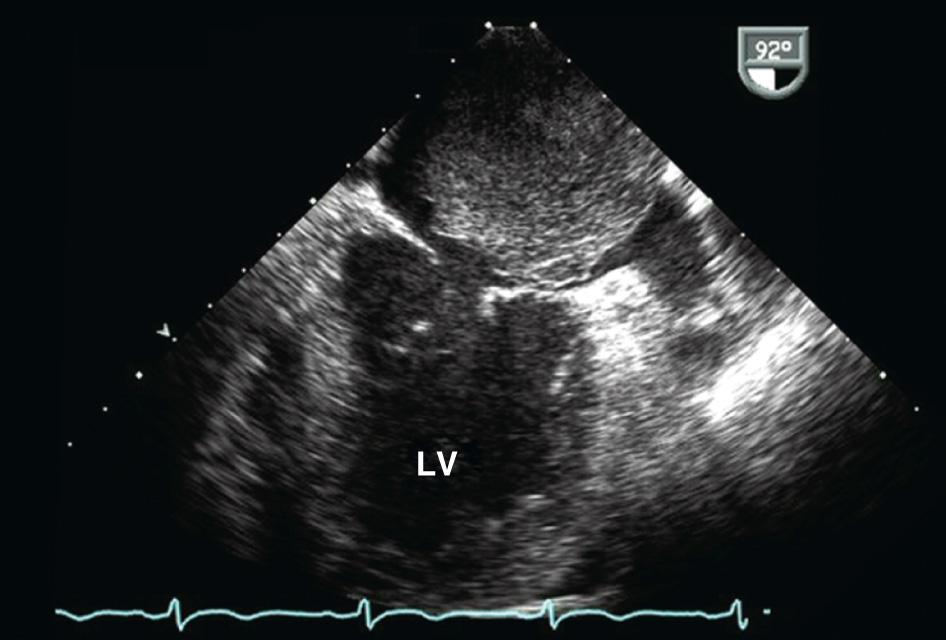
Findings on a chest roentgenogram of a myxoma may be absent in approximately one-third of persons. Calcification on the chest roentgenogram is more diagnostic of right atrial myxoma but may occasionally be present with left atrial myxomas. Before the availability of echocardiography, angiography was used to identify myxomas; currently, however, angiography is probably only useful to determine coronary anatomy, if considered necessary. CT and MRI can help delineate the extent of a tumor and its relation to surrounding cardiac and thoracic structures. MRI is especially valuable in the diagnosis of myxoma when masses are equivocal or suboptimal with echocardiography or if the tumor is atypical in presentation. Difficulty may arise in differentiating a thrombus from a myxoma, because both are so heterogeneous.
Transthoracic echocardiography (TTE) is excellent for identifying intracavitary tumors, because it is noninvasive, identifies tumor type, and permits complete visualization of each cardiac chamber. TTE is the predominant imaging modality for screening. Transesophageal echocardiography (TEE) allows for better definition of tumor size and location and can be used to identify the site of tumor attachment and the presence of multiple lesions.
When the primary reason for cardiac surgery is the removal of an intracardiac mass, an intraoperative transesophageal echocardiographic evaluation should take place before the surgical incision to ensure that the mass is still present and has not embolized or even dissolved, as in the case of intracardiac thrombus. In the case of myxoma, an intraoperative examination in the presence of the surgeon can aid in finalizing the surgical plan and in detecting previously unseen tumors. After tumor removal, the goal of TEE is to ensure that all visible mass was removed and that no damage occurred to adjacent structures. Specifically, in the case of a myxoma attached to the atrial septum, ensuring that no interatrial shunting has occurred after resection is important. If the tumor was attached on or adjacent to the valvular apparatus, then the examiner must determine whether the valve is competent after removing the tumor.
The first surgical resection of an atrial myxoma was performed in 1954. Subsequently, surgical resection has been recommended even if the myxoma is discovered incidentally, primarily because the risk of embolization to the central nervous system may be 30% to 40%. Surgery is associated with a mortality rate between 0% and 7%. More important, recent studies show that the long-term survival of an individual who has undergone myxoma resection is no different from age- and gender-matched populations.
Papillomas (papillary fibroelastoma) are rare, benign tumors that tend to affect the cardiac valves. Mostly singular (90%), 1 to 4 cm in size, highly papillary, pedunculated, and avascular, papillomas are covered by a single layer of endothelium containing fine elastic fibrils in a hyaline stroma ( Fig. 18.2 ). They originate most commonly from valvular endocardium, usually involving the ventricular surface of the aortic valve or the atrial surface of the mitral valve, but they only infrequently render the involved valve incompetent. Adults between the ages of 40 and 80 years are primarily affected, with a mean age of 60 years at the time of detection. Many patients are asymptomatic; therefore it is not surprising that 47% of these tumors are discovered incidentally during echocardiography, catheterization, or even cardiac surgery. Echocardiographically they may appear similar to vegetations seen in endocarditis, or they may be confused with Lambl excrescences, which tend to be more nodular in appearance.
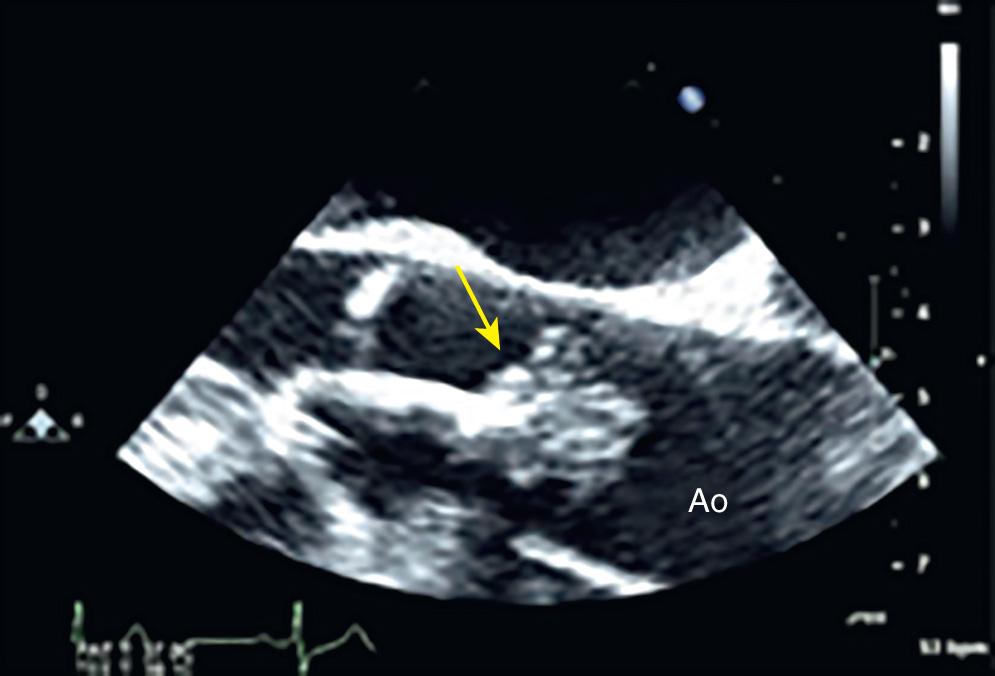
Although papillary fibroelastomas were previously believed to be harmless, postmortem studies have shown a high incidence of embolization to the cerebral and coronary circulations. Not surprisingly, symptoms are often related to stroke or transient ischemic attack and myocardial infarction (MI). Surgical resection is curative but may require valvular repair or replacement in one-third of cases. Recurrence is very rare.
Approximately 25% of primary cardiac tumors are malignant, and 95% of these are sarcomas. They are found infiltrating the RA and causing cavitary obstruction but may have variable clinical presentations based on the location, causing the diagnosis to be elusive. Primary malignant tumors usually occur between the ages of 30 and 50 years and are preceded by vague symptoms such as dyspnea, rapidly progressing to death. Angiosarcomas, the most common sarcoma, are rapidly spreading vascular tumors that arise most often from the RA and appear near the inferior vena cava (IVC) with extension to the mediastinum. Presenting symptoms include chest pain and dyspnea, progressive congestive heart failure (CHF), and bloody pericardial effusion. Treatment is palliative, because the response to chemotherapy and radiation is poor. Resection may be possible, but survival is less than 2 years. Rhabdomyosarcomas are aggressive tumors that have cellular elements that resemble striated muscle. Surgical resection is possible, but distant metastasis reduces the chances of success. Chemotherapy and radiation are ineffective.
In general, malignant primary cardiac tumors may require a combination of surgery, radiation, and chemotherapy to limit cavitary obstruction to blood flow because of rapid growth and metastasis. Local recurrence is more likely to cause death than metastasis. Although still controversial, orthotopic heart transplantation may be considered for unresectable tumors that involve only the heart, but survival is not extended beyond 1 to 2 years. The rate of intraoperative death with malignant tumor resection is seven times that of benign resection, and the morbidity rate is twice as high.
Although rare in general, secondary or metastatic cardiac tumors are far more common than primary tumors. These tumors may affect primarily the pericardium, the epicardium, the myocardium, or the endocardium. The site of metastasis frequently provides clues to the means of metastasis. Pericardial involvement, for example, often occurs via the direct extension from surrounding intrathoracic structures or from lymphatic spread, whereas endocardial lesions typically reflect hematogenous spread, and epicardial and myocardial lesions tend to arise from lymphatic extension.
Tumors exhibiting high rates of cardiac metastases include mesothelioma (48.4%), melanoma (27.8%), pulmonary adenocarcinoma (21%), undifferentiated lung carcinoma (19.5%), pulmonary squamous cell carcinoma (18.5%), and breast carcinoma (15.5%), although other autopsy series suggest that esophageal carcinoma may also be commonly found in cases of cardiac metastases. When considered by means of extension, direct extension is most likely to occur with tumors of the lung, breast, and esophagus, whereas hematogenous seeding is more likely with melanomas, and lymphatic spread is associated with lymphomas and leukemias. Venous extension, primarily involving right-sided cardiac structures, occurs with tumors of the kidneys (renal cell carcinoma), liver (hepatocellular carcinoma), and uterus (uterine leiomyosarcoma).
Unsurprisingly, the prognosis with a diagnosis of metastatic cardiac disease is poor. In one recent small series, 53.4% of patients diagnosed with metastatic lesions were deceased at 1 year. Although surgical intervention is not typically contemplated, 53.5% of the patients with metastatic disease in that series underwent surgical resection. Of those who underwent resection, 56.5% were alive at 1 year.
Anesthetic management of patients with cardiac tumors is likely guided first by the patient's comorbidities and second by tumor location.
In addition to the American Society of Anesthesiologists standard monitors providing continual evaluation of oxygenation, ventilation, circulation, and temperature, anesthesia for resectioning a cardiac tumor will undoubtedly involve placing an arterial line for continuous hemodynamic monitoring and establishing central venous access for vasoactive drug administration, volume infusion, and pressure monitoring. The timing of arterial line placement with respect to anesthetic induction should be guided by the patient's comorbidities and provider experience. Similarly, the choice of catheters and their placement locations for central venous access should be guided by the patient's pathologic condition and the surgical skill of the provider.
Anesthetic management is guided by tumor location in addition to patient comorbidity. Left atrial myxomas, for example, will most likely cause mitral valve obstruction, often in conjunction with pulmonary venous hypertension. Anesthetic management will closely resemble that of a patient with mitral stenosis. In contrast, right atrial myxomas may produce signs of right-sided heart failure that correspond to tricuspid valve obstruction. Positioning the patient for surgery must be carefully performed to detect severe restriction of venous return that may often be quickly followed with profound hypotension and arrhythmias. A large tumor may increase the likelihood of hemodynamic instability, whereas small tumors may be associated with increased risk of embolization. Perioperative arrhythmias, especially atrial fibrillation or atrial flutter, may arise in 25% of these patients and may require immediate treatment.
Carcinoid tumors are metastasizing neuroendocrine tumors that arise primarily from the small bowel, occurring in 1 to 2 per 100,000 people in the population. Upon diagnosis, 20% to 30% of individuals with carcinoid tumors exhibit the symptoms of carcinoid syndrome, characterized by episodic vasomotor symptoms, bronchospasm, hypotension, diarrhea, and right-sided heart disease attributed to the release of serotonin, histamine, bradykinins, and prostaglandins, often in response to manipulation or pharmacologic stimulation. Manifestations of carcinoid syndrome occur primarily in patients with liver metastasis that impairs the ability of the liver to inactivate large amounts of vasoactive substances.
Initially described in 1952, carcinoid heart disease may occur in 20% to 50% of patients with carcinoid syndrome. The prognosis has improved substantially in the last 20 years for individuals with malignant carcinoid tumors and carcinoid heart disease, but it still causes considerable morbidity and mortality. The median life expectancy is 5.9 years without carcinoid heart disease but falls to 2.6 years if it is present.
Carcinoid heart disease characteristically produces tricuspid regurgitation and mixed pulmonic stenosis and regurgitation resulting in severe right-sided heart failure. Tumor growth in the liver permits large amounts of tumor products to reach the RV without the benefit of first-pass hepatic metabolism. Carcinoid plaques composed of myofibroblasts, collagen, and myxoid matrix are deposited primarily on the tricuspid and pulmonary valves, bringing about immobility and thickening of the valve leaflets, causing the distinctive valvular changes. At the time of surgery, 80% of tricuspid valves are observed to be incompetent compared with only 20% with stenosis, whereas the affected pulmonary valves tend to be equally divided between incompetence and stenosis. The exact mechanism that causes valve injury is unknown, but high levels of serotonin are sometimes found in patients with carcinoid heart disease. Fewer than 10% of those with carcinoid heart disease have left-sided heart involvement, possibly attributable to inactivation of serotonin in the lungs, but either the mitral or aortic valve may be affected in the presence of a bronchial carcinoid, a right-to-left intracardiac shunt, or poorly controlled disease with high levels of circulating vasoactive substances.
A careful search for a patent foramen ovale (PFO) should be undertaken, because its presence raises the possibility of left-sided valvular involvement.
Historically, the prognosis of patients with carcinoid syndrome has been poor. In the absence of treatment, median survival was 38 months from the time of development of systemic symptoms. With the development of cardiac involvement and frank carcinoid heart disease, median survival has dropped to a dismal 11 months. Improvements in medical management and surgical technique, however, have led to improved symptom control and a lower mortality rate. Although the introduction of somatostatin analogs in the mid-1980s was associated with improved symptom control, no evidence suggested that their use was associated with improved survival. Currently, two somatostatin analogs are available for treatment: octreotide and lanreotide.
Treatment of the tumor and the malignant carcinoid syndrome does not result in regression of carcinoid heart disease. The surgical replacement of both the tricuspid and pulmonary valves with either bioprosthetic or mechanical valves is the only viable therapeutic option. The optimal timing of surgical intervention is uncertain but should be considered when signs of right-sided heart failure appear, if not before.
Patients who have carcinoid heart disease and require cardiac surgical intervention pose an anesthetic challenge. A carcinoid crisis with exuberant vasoactive-mediator release is a life-threatening event that may be precipitated by patient anxiety and fear in anticipation of surgical intervention. A variety of pharmacologic agents, including thiopental, meperidine, morphine, atracurium, and succinylcholine, as well as catecholamines such as epinephrine, norepinephrine, dopamine, and dobutamine, have all been implicated, in crisis precipitation. Furthermore, physical stimulation that may occur with laryngoscopy and endotracheal intubation, vascular access placement and the placement of urinary catheters, and tumor manipulation that may occur during tumor resection may also elicit a brisk release of vasoactive mediators.
Perioperative patient management is facilitated with optimal preoperative symptom control with carefully monitored administration and up-titration of a long-acting somatostatin analog formulation, supplemented preoperatively with additional subcutaneous injections of short-acting medications. Some institutions initiate an octreotide infusion at doses between 50 and 100 µg per hour the night before surgery or the day of surgery in the preoperative holding area, while providing additional intravenous doses of 20 to 100 µg as indicated clinically during anesthetic management. Incidentally, it should be noted that severe hyperglycemia may occur with octreotide because of its inhibition of insulin secretion, especially in combination with steroids.
Because patient anxiety and stress may provoke a carcinoid crisis, consideration should be given to judicious administration of preoperative anxiolytic agents. A variety of strategies have been recommended; however, for a patient whose symptoms are well controlled preoperatively on a regimen of long- and short-acting octreotide or its equivalent, it is likely the case that the drugs used matter less than how they are used and matter less than the vigilance of the anesthesiologist directing the patient's care.
Although renal cell carcinoma may not normally be considered a topic in cardiac anesthesia, cardiac anesthesia team members may increasingly find themselves caring for patients with renal cell carcinoma with significant venous extension. Renal cell cancers represent 2% to 3% of adult malignancies but are the most common and most deadly of renal neoplasms, accounting for approximately 90% of all renal cancers and conferring historic mortality rates between 30% and 40%. Although classically diagnosed by a combination of flank pain, hematuria, and a palpable mass, most renal cell cancers are now found incidentally during radiographic evaluation for other reasons. A small (2–3%) proportion of the cancers may be associated with familial syndromes, such as von Hippel-Lindau disease, although smoking, obesity, and hypertension are considered the three primary modifiable risk factors.
Historically, surgery for level III and IV tumors has been performed on cardiopulmonary bypass (CPB), often using deep hypothermic circulatory arrest. In an attempt to avoid exposure to extracorporeal circulation, to avoid the neurologic morbidity associated with profound hypothermia and circulatory arrest, and to avoid the ravages of massive transfusion, surgeons have developed strategies for both on-pump resection without hypothermic arrest and off-pump resection, even in the case of lesions extending into the RA ( Fig. 18.3 ).
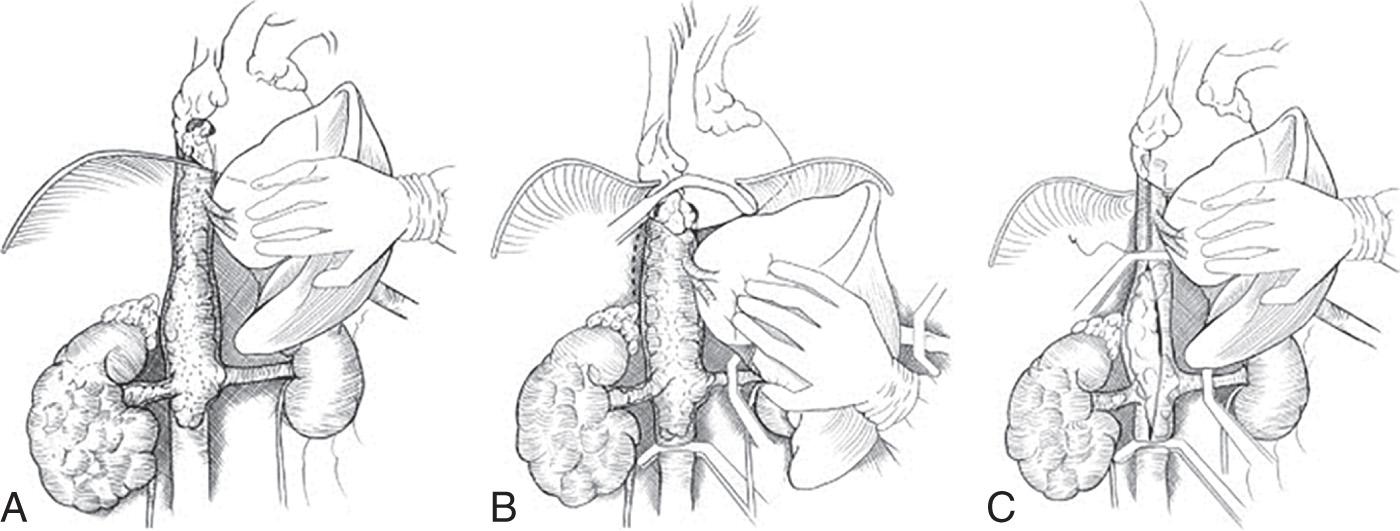
Anesthetically, the most important concerns in caring for patients undergoing radical nephrectomy and tumor thrombectomy will be establishing sufficient venous access and performing a thorough intraoperative transesophageal echocardiogram. Placement of a pulmonary artery catheter (PAC) may be unnecessary in patients with normal preoperative biventricular function and may be contraindicated in patients with tumor thrombus extending high into the supradiaphragmatic IVC and RA. Placement of femoral venous catheters for volume use intraoperatively may be of little use, considering the need to interrupt IVC blood flow for surgical resection. For on-pump procedures, consideration should be given to avoiding the use of antifibrinolytic agents, considering a patient's clear hypercoagulable state, although data to guide a rational choice are practically nonexistent.
In 1995 the World Health Organization (WHO) and the International Society of Cardiology (ISC) redefined the cardiomyopathies according to dominant pathophysiologic considerations or, if possible, by “etiological/pathogenetic factors.” Cardiomyopathies were then defined as “diseases of the myocardium associated with cardiac dysfunction.” The original cardiomyopathies, classified as dilated cardiomyopathy (DCM), restrictive cardiomyopathy (RCM), and hypertrophic cardiomyopathy (HCM), were preserved, and arrhythmogenic right ventricular cardiomyopathy (ARVC) was added.
Based on the American Heart Association (AHA) definition, cardiomyopathies may be divided into primary and secondary classifications, depending upon the primary organ involvement. Whereas primary cardiomyopathies are confined generally to the myocardium, secondary cardiomyopathies reflect myocardial involvement in the context of a systemic disorder. Primary cardiomyopathies primarily affecting the heart may, in turn, be classified as genetic, mixed, or acquired ( Fig. 18.4 ). Secondary cardiomyopathies, in which cardiac involvement occurs in the context of a systemic disorder, are more numerous ( Box 18.1 ).
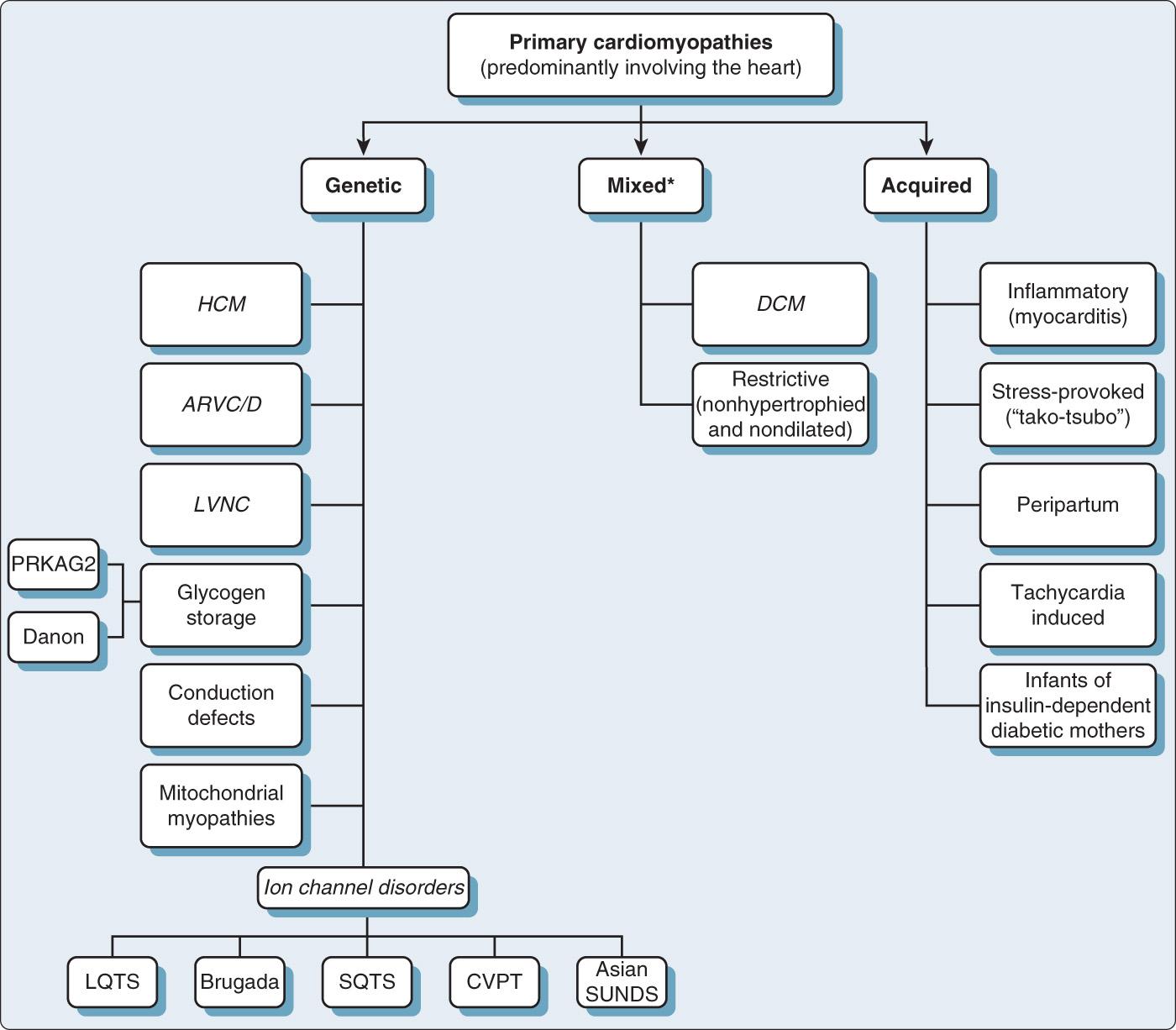
Infiltrative a
a Extracellular deposition of abnormal substances among myocytes.
Storage c
c Extracellular deposition of abnormal substances within myocytes.
Toxicity
Drugs, heavy metals, chemical agents
Endomyocardial
Endomyocardial fibrosis
Hypereosinophilic syndrome (Löffler endocarditis)
Inflammatory (granulomatous)
Sarcoidosis
Endocrine
Diabetes mellitus b
Hyperthyroidism
Hypothyroidism
Hyperparathyroidism
Pheochromocytoma
Acromegaly
Cardiofacial
Neuromuscular and neurologic
Nutritional deficiencies
Beriberi (thiamine), pellagra, scurvy, selenium, carnitine, kwashiorkor
Autoimmune and collagen
Systemic lupus erythematosus
Dermatomyositis
Rheumatoid arthritis
Scleroderma
Polyarteritis nodosa
Electrolyte imbalance
Consequence of cancer therapy
Anthracyclines: doxorubicin (Adriamycin), daunorubicin
Cyclophosphamide
Radiation
As if to confuse the subject further, the European Society of Cardiology Working Group on Myocardial and Pericardial Diseases presented its own classification scheme in 2008. According to the European scheme, cardiomyopathies were divided much as they had been by WHO and the International Society and Federation of Cardiology into hypertrophic, dilated, arrhythmogenic right ventricular, restrictive, and unclassified; and each category, in turn, could be subdivided into familial and genetic or nonfamilial and nongenetic ( Fig. 18.5 ).
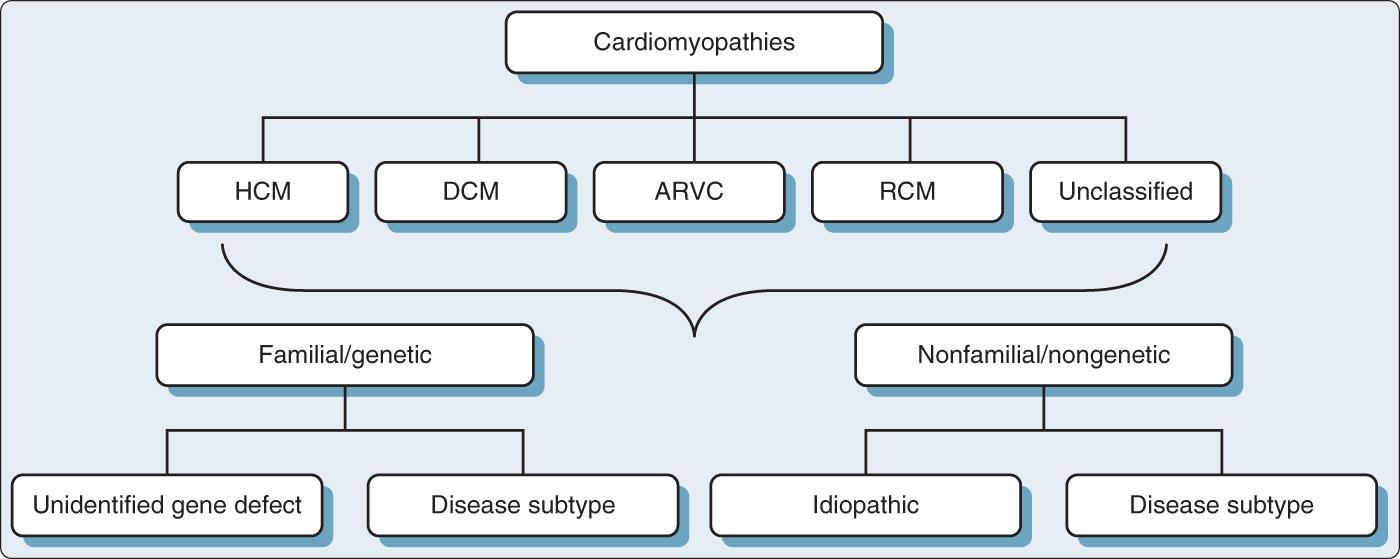
With the lack of a consensus on a definition of cardiomyopathy and with its numerous subtypes, it is difficult, if not impossible, to speak of its epidemiologic factors, although likely not uncommon. DCM alone, of whatever cause, has been estimated to have an annual incidence of 5 to 8 cases per 100,000 population and a prevalence in the United States of 36 cases per 100,000 population, leading to approximately 10,000 deaths annually. HCM is even more common, if not the most common inherited cardiomyopathy, with an estimated prevalence between 1 : 500 and 1 : 200 and an estimated prevalence of at least 700,000 in the United States alone. Given this burden of disease, anesthesia providers are likely to encounter patients with a cardiomyopathy in both cardiac and noncardiac surgical units.
In the sections that follow, this text adheres to the WHO and European Society classification, presenting overviews of DCM, HCM, RCM, and ARVC and followed, in turn, by a discussion of the salient points of their anesthetic management ( Table 18.2 ).
| Characteristics | Hypertrophic Cardiomyopathy | Dilated Cardiomyopathy | Arrhythmogenic Right Ventricular Cardiomyopathy | Restrictive Cardiomyopathy |
|---|---|---|---|---|
| Clinical | ||||
| Heart failure | Occasional (LV) | Frequent (LV or BV) | Frequent (RV) | Frequent (BV) |
| Arrhythmias | Atrial and ventricular arrhythmias | Atrial and ventricular arrhythmias, conduction defects | Ventricular tachycardia (RV), conduction defects | Atrial fibrillation |
| Sudden death | 0.7–11% per year | Frequent (ND) | Frequent (ND) | 1–5% per year |
| Hemodynamically | ||||
| Systolic function | Hyperdynamic, outflow tract obstruction (occasionally) | Reduced | Normal-reduced | Near normal |
| Diastolic function | Reduced | Reduced | Reduced | Severely reduced |
| Morphologic | ||||
| Cavity size | ||||
| Ventricle | Reduced (LV) | Enlarged (LV or BA) | Enlarged (RV) | Normal or reduced (BV) |
| Atrium | Normal-enlarged (LA) | Enlarged (LA or BA) | Enlarged (RV) | Enlarged (BA) |
| Wall thickness | Enlarged, asymmetric (LV) | Normal-reduced (LV or BV) | Normal-reduced (RV) | Normal (BV) |
Formerly referred to as congestive cardiomyopathy or idiopathic cardiomyopathy, DCM is by far the most common of the four cardiomyopathies in adults in the WHO and European Society classification. As developments in molecular biology and genetics have provided better insight into the pathogenesis of DCMs, the term idiopathic has become less applicable.
Acknowledging the limitations of any taxonomy, the DCMs run a spectrum from genetic to acquired with an overlap in the middle. The genetics of DCMs and the genetics of familial DCM are complicated and the causes of acquired DCMs are diverse ( Box 18.2 ).
Idiopathic dilated cardiomyopathy
Idiopathic arrhythmogenic right ventricular dysplasia
Autosomal dominant
X-chromosomal
Polymorphism
Other
Ethanol
Cocaine
Adriamycin
Catecholamine excess
Phenothiazines, antidepressants
Cobalt
Carbon monoxide
Lead
Lithium
Cyclophosphamide
Methysergide
Amphetamine
Pseudoephedrine or ephedrine
Viral (coxsackievirus, parvovirus, adenovirus, echovirus, influenza virus, human immunodeficiency virus)
Spirochete (leptospirosis, syphilis)
Protozoal (Chagas disease, toxoplasmosis, trichinosis)
Collagen vascular disease (scleroderma, lupus erythematosus, dermatomyositis, rheumatoid arthritis, sarcoidosis)
Kawasaki disease
Hypersensitivity myocarditis
Postpartum cardiomyopathy
Obesity
Thiamine
Kwashiorkor, pellagra
Scurvy
Selenium deficiency
Carnitine deficiency
Become a Clinical Tree membership for Full access and enjoy Unlimited articles
If you are a member. Log in here